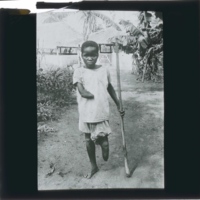
A Young Boy
A young boy (Impongi) with a severed hand and foot, mutilated by sentries after his village failed to meet its rubber quota. He was a witness before King Leopold II's Commission of Enquiry which was an unsuccessful attempt to refute Roger Casement's damning report to the British government on human rights abuses in the Congo Free State. This image formed part of the Harris Lantern Slide Collection. Under King Leopold II the Congo Free State used mass forced labour to extract rubber from the jungle for the European market. As consumer demand grew King Leopold II's private army - the Force Publique - used violent means to coerce the population into meeting quotas, including murder, mutilation, rape, village burning, starvation and hostage taking. Alice Seeley Harris and her husband Reverend John H. Harris were missionaries in the Congo Free State from the late 1890s. Alice produced a collection of images documenting the horrific abuses of the African rubber labourers. Her photographs are considered to be an important development in the history of humanitarian campaigning. The images were used in a number of publications. The Harrises also used the photographs to develop the Congo Atrocity Lantern Lecture which toured Britain and the the USA raising awareness of the issue of colonial abuses under King Leopold II's regime. Source: Antislavery International and Panos Pictures.
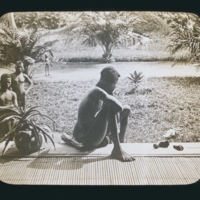
Nsala of Wala (2)
Nsala of Wala with the severed hand and foot of his five year old daughter murdered by ABIR militia. (Anglo-Belgian India Rubber company). This image formed part of the Harris Lantern Slide Collection. Under King Leopold II the Congo Free State used mass forced labour to extract rubber from the jungle for the European market. As consumer demand grew King Leopold II's private army - the Force Publique - used violent means to coerce the population into meeting quotas, including murder, mutilation, rape, village burning, starvation and hostage taking. Alice Seeley Harris and her husband Reverend John H. Harris were missionaries in the Congo Free State from the late 1890s. Alice produced a collection of images documenting the horrific abuses of the African rubber labourers. Her photographs are considered to be an important development in the history of humanitarian campaigning. The images were used in a number of publications. The Harrises also used the photographs to develop the Congo Atrocity Lantern Lecture which toured Britain and the the USA raising awareness of the issue of colonial abuses under King Leopold II's regime.Source: Antislavery International and Panos Pictures.
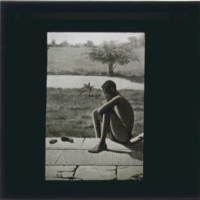
Nsala of Wala
Nsala of Wala with the severed hand and foot of his five year old daughter murdered by ABIR militia. (Anglo-Belgian India Rubber company). Sketch based on a photograph taken by Alice Seeley Harris. This image formed part of the Harris Lantern Slide Collection. Under King Leopold II the Congo Free State used mass forced labour to extract rubber from the jungle for the European market. As consumer demand grew King Leopold II's private army - the Force Publique - used violent means to coerce the population into meeting quotas, including murder, mutilation, rape, village burning, starvation and hostage taking. Alice Seeley Harris and her husband Reverend John H. Harris were missionaries in the Congo Free State from the late 1890s. Alice produced a collection of images documenting the horrific abuses of the African rubber labourers. Her photographs are considered to be an important development in the history of humanitarian campaigning. The images were used in a number of publications. The Harrises also used the photographs to develop the Congo Atrocity Lantern Lecture which toured Britain and the the USA raising awareness of the issue of colonial abuses under King Leopold II's regime.Source: Antislavery International and Panos Pictures.
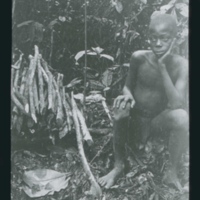
Young Boy Forced to Collect Rubber
A young boy forced to collect rubber for the Anglo-Belgium India Rubber Company (ABIR). The rubber quotas imposed on the indigenous population were so great that, as in this picture, the rubber vines were cut down rather than waiting for them to be tapped. As a result hardly any vines were left around the rubber stations. This image formed part of the Harris Lantern Slide Collection. Under King Leopold II the Congo Free State used mass forced labour to extract rubber from the jungle for the European market. As consumer demand grew King Leopold II's private army - the Force Publique - used violent means to coerce the population into meeting quotas, including murder, mutilation, rape, village burning, starvation and hostage taking. Alice Seeley Harris and her husband Reverend John H. Harris were missionaries in the Congo Free State from the late 1890s. Alice produced a collection of images documenting the horrific abuses of the African rubber labourers. Her photographs are considered to be an important development in the history of humanitarian campaigning. The images were used in a number of publications. The Harrises also used the photographs to develop the Congo Atrocity Lantern Lecture which toured Britain and the the USA raising awareness of the issue of colonial abuses under King Leopold II's regime. Source: Antislavery International and Panos Pictures.
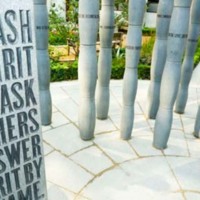
Gilt of Cain
Gilt of Cain was unveiled by the Archbishop Emeritus Desmond Tutu in Fen Court, City of London, in September 2008. The artwork, a collaboration by sculptor Michael Visocchi and poet Lemn Sissay, commemorates the abolition of the transatlantic slave trade. The granite sculpture is composed of a group of columns surrounding a podium – suggesting an ecclesiastical pulpit or slave auctioneer’s block. Extracts from Lemn Sissay’s poem, ‘Gilt of Cain’, are engraved into the granite.
Fen Court is the site of a churchyard formerly of St Gabriel’s Fenchurch St and now in the Parish of St Edmund the King and St Mary Woolnoth, Lombard St. The latter has a strong historical connection with the British abolitionist movement of the 18th and 19th centuries: Reverend John Newton, a slave-trader turned preacher and abolitionist, was rector of St Mary Woolnoth between 1780 – 1807. This project was initiated by Black British Heritage and the Parish of St Mary Woolnoth and was commissioned by the City of London Corporation in partnership with the British Land Company.
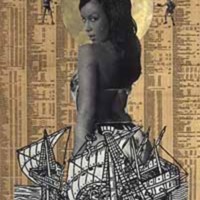
Lace and Slavery
During the Industrial Revolution Nottingham was famous for the manufacture of lace. In 2007 British-Ghanaian artist Godfried Donkor, supported by The New Art Exchange and the Centre for Contemporary Art in the city, investigated the often-neglected connections between this luxurious commodity and the cotton picked by enslaved Africans in the Caribbean and American South. The research culminated in an exhibition, ‘Once Upon a Time in the West There Was Lace’, at the Yard Gallery at Wollaton Hall in early 2008. The Elizabethan manor is also home to the Industrial Museum which holds lace-making machinery. A key part of the display were outfits created from brightly coloured lace, now a prized material in West Africa. Donkor's paintings on pages of the Financial Times represented people, culture and goods crossing the Atlantic in different eras. The exhibition was accompanied by a series of public events which looked at the links between the city’s past lace-making industry and slavery, including lectures and a free symposium.
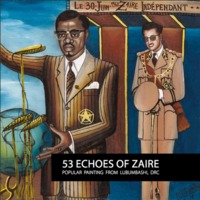
53 echoes of Zaire: Popular Painting from Lubumbashi Democratic Republic of Congo, Sulger-Buel Lovell Gallery, London (27 May – 30 June 2015)
Popular Painting is a genre traceable to the 1920s, which chronicles contemporary social and political realities in Congo (then Zaïre). This art movement remains very little known outside the continent. Scholars have dedicated their research activities to Popular Painting. They often knew the main actors of the movement in the early 1970s, and shared this knowledge by publishing articles, books and exhibition catalogues. “ During a brief period between the late sixties and the late seventies, popular genre painting bloomed in the urban and industrial Katanga region of the Democratic Republic of the Congo Artists, most of them self-educated, produced paintings (acrylics or oils on canvas reclaimed from flour sacking) for local use. Through a limited number of recurrent topics, they articulated a system of shared memories.
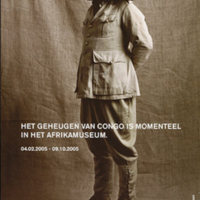
The Memory of the Congo in the Colonial Era, Royal Museum for Central Africa, Tevuren, Belgium ( 4 February 2005 - 9 October 2005)
With this exhibition, the RMCA aims to contribute to the highly topical debate concerning the colonial history of Congo and Belgium.
Visitors learn more about this controversial period through little-known objects, works of art, documents, films, and photographs. Filmed interviews with Belgians and Congolese give a voice to the past in a lively confrontation with memories and emotions. Memory of Congo, through specific themes and diverse narratives, revisits this turbulent chapter in history
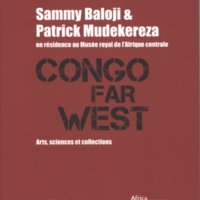
Artists in Residence. Sammy Baloji & Patrick Mudekereza,
Congo Far West, Royal Museum for Central Africa, Tevuren, Belgium (11 May – 4 September 2011)
In this exhibition the artists Sammy Baloji and Patrick Mudekereza present us with a contemporary take on the colonial past. As artists in residence in the museum they got carte blanche in the museum collections. In dialogue with scientists from the museum they have started working with a few collection pieces dating from the beginning of Congo’s colonial history. These collection pieces exhale the atmosphere of the conquest of Congolese territory by the West. The leitmotif of the exhibition ‘Congo Far West’ refers not only to this territorial conquest, but also to the contemporary Congolese artists who artistically and intellectually recapture the collection pieces conserved in the West.
Patrick Mudekereza is a writer and poet but he also writes texts for comic strips, exhibitions and audiovisual art. During his time in the museum he is working on a hybrid sculpture entitled L’art au Congo which raises a whole host of questions, and treaties signed with a cross which sealed the transfer of land from the local chefs to Leopold II. Photographer Sammy Baloji is working on a series of photographs and watercolours from a colonial exhibition led by Charles Lemaire. He has already exhibited in cities such as Paris, Bamako, Brussels, Cape Town and Bilbao. A Beautiful Time, his first solo exhibition in the United States, taking place in the Museum for African Art in New York, will be on show in in the Smithsonian National Museum of Natural History in Washington in 2012. Sammy Baloji and Patrick Mudekereza both live and work in Lubumbashi in DR Congo. Together they are organising the photography biennale Rencontres Picha in Lubumbashi, the third edition of which will take place in 2012.
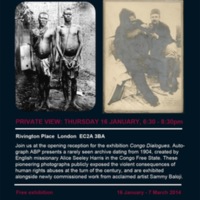
'When harmony goes to hell'. Congo Dialogues: Alice Seeley Harris and Sammy Baloji, Rivington Place, London (16 January - 7 March 2014)
Autograph ABP presents a rarely seen archive dating from 1904, created by English missionary Alice Seeley Harris in the Congo Free State. These pioneering photographs publicly exposed the violent consequences of human rights abuses at the turn of the century, and are exhibited alongside newly commissioned work from acclaimed contemporary Congolese artist Sammy Baloji.
In the early 1900s, the missionary Alice Seeley Harris produced what was probably the first photographic campaign in support of human rights. She exposed the atrocities that underpinned King Leopold II’s regime in the Congo Free State, bringing to public attention the plight of the Congolese people under a violent and oppressive regime.
These photographs fundamentally shifted public awareness of the deep-rooted hypocrisy of King Leopold II’s promise of colonial benevolence, and caused an outcry at the time of their publication in Europe and America.
Over 100 years later, these issues remain of primary concern to Congolese citizen and artist Sammy Baloji. Like Harris, Baloji uses photography as a medium to interrogate current political concerns with reference to the past. Acclaimed for his photomontage works that juxtapose desolate post-industrial landscapes with ethnographic archival imagery, Baloji explores the cultural and architectural ‘traces’ of a country forever haunted by the spectres of its colonial past; in particular, the southeastern Katanga province and its capital, the city of Lubumbashi.
In this new body of work-in-progress, commissioned by Autograph ABP, Baloji continues to investigate the colonial legacies and fractured histories that haunt contemporary Congolese society. Notions of African utopias, post-colonial disillusionment, and a quest for authenticity amidst ‘the ruins of modernity’ define Baloji’s multi-layered practice: the impact of Western imperialism, Maoist communism, urban segregation and colonial sanitation politics as well as the unending mineral exploitation of the Congo’s natural resources, and with it the tragedies and traumas of state-controlled violence and ongoing human rights abuses.
Congo Dialogues marks the 175th anniversary of Anti-Slavery International and the invention of photography. The first major solo showcase of Sammy Baloji’s work in the UK, this exhibition presents a unique opportunity to see both historical and contemporary works interrogating the Congo and its colonial legacies. The Alice Seeley Harris archive was last shown to the public 110 years ago.
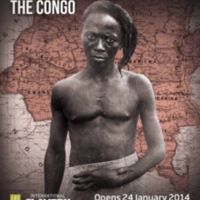
Brutal Exposure, International Slavery Museum, Liverpool (24 January 2015 - 7 June 2015)
This haunting exhibition documented the exploitation and brutality experienced by Congolese people under the control of Leopold II of Belgium in the 1900s. The photographs, by missionary Alice Seeley Harris, were at the time a radical and significant shift in the representation and understanding of the impact of colonial violence in the Congo, and exposed the deep-rooted hypocrisy of so called 'colonial benevolence' which cost the lives of millions of Congolese. The campaign led to public pressure and international scrutiny of Leopold’s administration, which came to an end in 1909.
The legacy of Belgian violence and exploitation would tragically re-emerge years later after the Congo gained independence in 1960, with the murder of the country’s first legally elected Prime Minister, Patrice Lumumba.
European exploitation of the Congolese people and resources has shaped the country's recent history and the effects are still evident today.
This exhibition was developed in partnership with Autograph ABP and Anti-Slavery International.
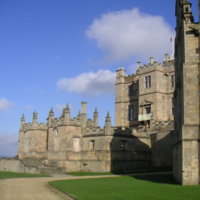
Slavery and the British Country House
In 2007 English Heritage (now Historic England) commissioned research into the linkages between properties in its care and transatlantic slavery, to coincide with events to commemorate the bicentenary. A report produced by historian Miranda Kaufmann identified 26 properties with some level of connection to slavery or abolition. As a result, more detailed surveys of four sites - Bolsover Castle, Brodsworth Hall, Marble Hill and Northington Grange - were commissioned in 2008, and the findings presented at the 'Slavery and the British Country House: mapping the current research' conference in 2009. The conference was organised by English Heritage in partnership with the University of the West of England, the National Trust and the Economic History Society. Findings were later published in 'Slavery and the British Country House' (2013), edited by Madge Dresser and Andrew Hann. The publication and the 2008 reports are available to download from Historic England's website.
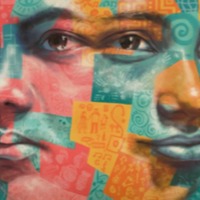
Aida
Aida was recruited as a child soldier by a militia group in the Philippines at the age of 14 and then prevented from leaving. She was engaged in armed conflict for six months, one of hundreds of thousands of children who participate in armies and armed groups in more than 30 countries around the world. The problem is most critical in Africa, where up to 100,000 children are estimated to be involved in armed conflict. Child soldiers also exist in Afghanistan, Burma, India, Indonesia, Iran, Iraq, Israel and the Occupied Palestinian Territories, though international law sets 18 as the minimum age for all participation in hostilities. In the Philippines, where three major insurgent groups have fought the Philippine military since the 1960s, there are an estimated 2000 child soldiers. The Communist-oriented New People’s Army, established in 1968, began an intense recruitment of children in the 1990s. By 2000, some 25 percent of new recruits were children, and more than ten percent of its regular combatants are now under 18. Parents volunteer children to serve as combatants and camp guards. The Moro Islamic Liberation Front allows the training of children as young as 12. Parents volunteer their children, seeing it as an observation of Islamic teaching, and Muslim youth organizations recruit students from schools and colleges. The Abu Sayyaf (“Bearer of the Sword”), a Muslim separatist group which appeared in the late 1980s, uses Islamic religion to draw minors into the movement, for use as combatants, human shields, and hostages.
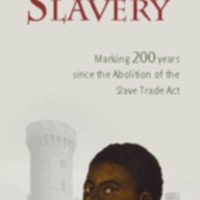
Wales and Slavery
The official publication produced to mark the bicentenary from the Wales Office.
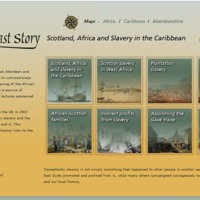
A North East Story: Scotland, Africa and Slavery in the Caribbean
This online exhibition and learning resource linking the history of transatlantic slavery to North East Scotland was organised by an Aberdeen and Aberdeenshire Bicentenary Committee, including representatives from Aberdeenshire Council, Aberdeen City Council, the University of Aberdeen, the Robert Gordon University and the African and African-Caribbean communities. It followed on from a service of commemoration and a series of public lectures sponsored by the Committee in 2007. The exhibition logo is inspired by the mythical Sankofa bird, a cultural symbol of the Akan-speaking peoples of Ghana in West Africa. Featured here are a number of resources available to download from the North East Story website.
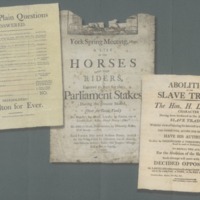
Harewood 1807
2007 saw a number of different projects taking place at Harewood House in West Yorkshire, home of the Lascelles family. The bicentenary was used as an opportunity to explore the family connections with the transatlantic slave trade and the sugar plantations of the West Indies.
As part of a newly developed Learning Programme, leaflets were produced setting out the family connections to Barbados. 2007 also marked the bicentenary of the Yorkshire election in 1807 contested by William Wilberforce, Henry Lascelles (later 2nd Earl of Harewood) and Lord Milton. Competition between the candidates was fierce, based on issues such as Catholic Emancipation, poverty, workers' rights and abolition of the slave trade.
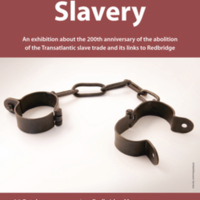
Redbridge and Slavery
Redbridge Museum's exhibition to mark the bicentenary examined the London Borough of Redbridge's connections to the slave trade and abolition. These links included local resident Josiah Child, once Governor of the East India Company, an investor in the Royal African Company and owner of plantations in Jamaica. The Mellish family of Woodford had connections with the West India Docks in London, built for the sugar trade. Alexander Stewart of Woodford owned Jamaican plantations and acted on behalf of owners of enslaved Africans in compensation claims after abolition. The exhibition also examined church records detailing some of the Black residents of Redbridge in the 17th and 18th centuries. Music from the Caribbean island of Dominica was included, as was a series of personal responses to the bicentenary by local residents.
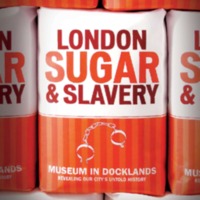
London, Sugar and Slavery
The Museum of London Docklands opened the London, Sugar and Slavery gallery in 2007, and it remains a permanent exhibition. The museum, housed in an old sugar warehouse on London’s West India Dock, retold the narrative of the transatlantic slave trade from the perspective of London, once the fourth largest slaving port in the world. Through personal accounts, film, music, interactive exhibits and over 140 objects, the exhibition looks at the various stages of the transatlantic slave trade, including life and trade on the West India Dock, and conditions for the enslaved on the Middle Passage and the Caribbean plantations. The final section of the gallery focuses on the legacies of the slave trade for British society today. Community collaborations also helped shape the gallery.
The museum also created a walking trail for the local area, highlighting key architectural features and buildings that had a role in the transatlantic slave trade. The Slave Map of London was developed in collaboration with three London museums: the Cuming Museum in Southwark, Bruce Castle Museum in Haringey and Fulham Palace Museum. Users navigated an online map to discover over 100 different locations throughout London which played a part in the transatlantic slave trade and the fight to end it. A schools programme that accompanied the opening of the exhibition included drama performances and workshops. Courses that ran alongside the exhibition in 2007 included ‘Resistance and Achievement: the story of African and Caribbean people in Britain’, in partnership with Middlesex University.
In 2018, the museum reflected on the 10 year anniversary of London, Sugar and Slavery with a workshop to explore the significance of the gallery, with contributions from artists, museum practitioners and emerging artists.
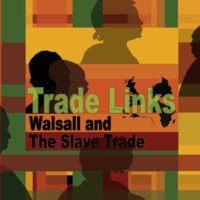
Trade Links: Walsall and the Slave Trade
An exhibition at Walsall Museum looked at Walsall's links with the slave trade, the background to the Abolition Act of 1807, and the legacies of slavery. Walsall's metal industry included chain making by local women of Cradley Heath, and the manufacture of guns used to trade for captive Africans. The exhibition was accompanied by a programme of presentations, lectures and workshops, including art sessions with local residents and the artist Pauline Bailey. Part of the wider project featured an online resource 'Abolition WYA' by Walsall Youth Arts, which encouraged young people to explore the topic of slavery and contribute poems, visual arts and music to express their views. Some of the images featured on the site are pictured here.
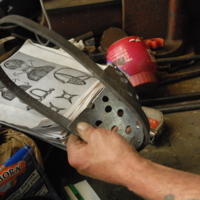
Sugar Coated Tears
This exhibition explored the links between industry in the West Midlands and the commercial gains of slavery. Wolverhampton's role as a manufacturer of iron was crucial to the economy of slavery, as implements of restraint and punishment were needed to repress those who fought their enslavement. The exhibition emerged from a collaboration between photographer Vanley Burke and blacksmith Lofty Wright. They re-created 40 cast iron instruments used in the slave trade: forked wooden yokes that controlled captives; irons, muzzles and braces that were used to constrain and as punishment. Each of the metal items was symbolically coated in sugar.